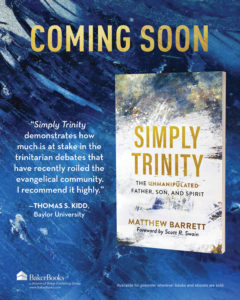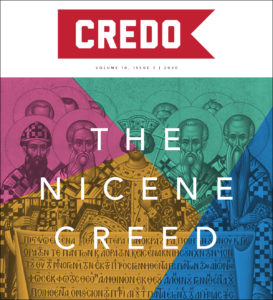The Church is often weak and prone to listen to the culture’s seductive call. We need help to focus our hearts upon God’s voice. God assists us through means that include the Creeds. Creeds are God’s gift to the Church – arising from listening attentively to God’s Word, the Creeds use liturgical repetition to draw us into deeper experiences of hearing what God really says to the Church. The world uses many powers to arrest our attention – including the power of compulsion. But Creeds have the “authority of the herald, not the magistrate.”[1]
From May to July 325 A.D. the first General Council of the Church was held at Nicaea. Another venue had been considered – the Roman emperor settled on the location in modern Turkey as a convenient place for bishops travelling from around the Roman Empire. Records of the number of bishops in attendance vary – Eusebius suggests more than 250 while Athanasius estimated about 300. The council is significant for both the nature of its deliberations and its pronouncements. The Creed was agreed by a Council; both the statement and process matter. Creeds are God's gift to the Church - arising from listening attentively to God's Word, the Creeds use liturgical repetition to draw us into deeper experiences of hearing what God really says to the Church. Click To Tweet
The Characters
The council was presided over by Constantine, Emperor of Rome. This brought a sense of pomp and the undeniable benefit of “tax exemption”[2] to the gathering. Having sought to bring some measure of unity to the church in the West regarding the Donatist schism, Constantine now wished to foster unity more widely regarding the teaching of Arius.
Constantine sent his top specialist on Church affairs, Bishop Hosius of Córdoba to discern the nature of the theological dispute. Like all good politicians, Constantine knew he could not be an expert on every issue – he deputised capable experts. Córdoba was able to explain that the Church was riven by arguments over the precise way in which God the Son differs from God the Father. Egyptian bishops were excommunicating Palestinian bishops; mobs of church goers from Bithynia were threatening the peace of Galatia. For the peace of his empire, Constantine called a council.
Before the emperor arrived to formally open proceedings, bishops met for a few days to discuss. At the conclusion of proceedings Constantine provided a banquet and lavish gifts to the bishops. The concerns of Constantine were doubtless different to those of the bishops on both sides of the theological debates. It is difficult to evaluate where Constantine’s political concerns ended and theological convictions began. Many bishops bore the gruesome scars from torture in the earlier Great Persecution. The opinions of such “confessors” were highly valued. Bishops who had been tortured under one Emperor, now were applauded by another as they debated fine points of trinitarian theology. The ironies of God’s providence and the suffering triumphs of his Church were on display.
Arius was a charismatic celebrity preacher. He sought to communicate his understanding of Christianity by popular songs. Rowan Williams observed that Arius’s aim was “to develop a biblically-based and rationally consistent catechesis.”[3] In pubs and at workplaces, people sang his theology. The problem was that church ministers and bishops were divided over the faithfulness of Arian doctrine. Arius elicited sympathy, “We are persecuted because we say ‘The Son has a beginning.”[4] He even cited scripture to defend his view. “Surely the Son came ‘from Him’ (Rom. 11:36) and the Son said ‘I came from the Father’ (Jn. 16:28).”[5]
Supporters of Arius’s outlook included Eusebius of Nicomedia and Eusebius of Caesarea. The former gave one of the first speeches at Nicaea – proposing an Arian statement of faith. It was rejected. The latter became famous for his highly valued Church History. He was a much loved bishop. He had “a lack of clearness in doctrine but was constantly a peacemaker.”[6] He thought the Nicene Creed led to Sabellianism, and though he signed the Creed at the behest of Constantine, he never used its language in any subsequent writings. He was pained to be viewed by many as a heretic because he had been censured at the earlier more localised Synod of Antioch. So Eusebius of Caesarea shared his own statement of faith which aimed to unite the divided parties. This also fell flat.
One observer of the pivotal moment in Church history was Athanasius – at the time the young assistant to the Bishop of Alexandria. Twenty-five years later Athanasius was still defending and elaborating the Nicene Creed. He noted ruefully that the councillor proceedings were “torturous and laborious.”[7]
When Nicaea concluded, only Arius and two bishops – Secundus of Ptolemais and Theonas of Marmarcia refused to sign the Creed that emerged. They were excommunicated and banished to Illyria. As soldiers transported them to their new existence, the majority of bishops tucked into the celebratory feast provided by Constantine, and collected the munificent gifts he gave those who upheld church unity. Excommunicating those who dissented from the Creed shows how seriously the church should take intellectual sins. Excommunicating those who dissented from the Creed shows how seriously the church should take intellectual sins. Click To Tweet
Within a few months some signatories, such as Eusebius of Nicomedia, were sent to join the Arian exiles. Embarrassingly, Bishop Theognis of Nicaea was one of those declared to be a heretic by virtue of the Creed agreed in his own city. He was exiled after the council concluded, but returned to office three years later, as local Arian power bases resurged. So the meaning and significance of the Nicene Creed continued to be debated for the rest of the 4th century, only in time settling in the hearts and minds of orthodox theologians as one of the foundational insights into the Faith.
The Council
The Bible shows the early church using a council to resolve an ecclesial disagreement (Acts 15:6). Turretin noted, “The apostles were infallible and on this account could have settled this controversy. They wished by their example under the guidance of the Holy Spirit to prescribe the order which should perpetually prevail in the church.”[8] The Council of Nicaea in 325 A.D. was not the first time the early Church followed the apostle’s example by holding a council. However councils that had met prior to Nicaea were more localised. Only a fraction of the bishops invited actually attended Nicaea, but the geographical spread of those who were in the discussions gave Nicaea credible grounds to be viewed as the first universal Church Council. From East and West, representatives travelled. From as far away as Britain, bishops came.
Disagreements are to be expected in the Church – the goal should be to handle them appropriately when they arise. Calvin was an assiduous student of the early church. His appreciation of Nicaea led him to agree with Cranmer that “in the present disturbed state of the church no more suitable remedy can be adop ted than the assembling together of godly and discreet men, well disciplined in the school of Christ, who shall openly profess their agreement in the doctrines of religion.”[9] Practicalities regarding councils can vary according to circumstances. Composition may include lay people or be drawn from the ordained; civil authorities may or may not be involved in calling them; concerns may be raised which are localised or international. If there are well functioning denominational structures they should be used – if not then new wineskins may be required. Still, wherever a council is called and regardless of the issues it seeks to resolve, the towering significance of Nicaea’s Council beckons the Church down the centuries to humbly recognise the power by which God can guide his church through conciliar gatherings.
ted than the assembling together of godly and discreet men, well disciplined in the school of Christ, who shall openly profess their agreement in the doctrines of religion.”[9] Practicalities regarding councils can vary according to circumstances. Composition may include lay people or be drawn from the ordained; civil authorities may or may not be involved in calling them; concerns may be raised which are localised or international. If there are well functioning denominational structures they should be used – if not then new wineskins may be required. Still, wherever a council is called and regardless of the issues it seeks to resolve, the towering significance of Nicaea’s Council beckons the Church down the centuries to humbly recognise the power by which God can guide his church through conciliar gatherings.
Nicaea was called to address the heretical teaching of Arius – but gathering people from so many far flung places, gave a golden opportunity to address numerous issues. So the council issued agreed statements on issues as wide-ranging as the date of Easter, restoring penitent sinners, clerical standards and liturgical practice. That matters such as these were discussed and agreed upon is surely a rebuke to our technologically sophisticated age. We are able via the internet to share ideas and information with Christians around the globe – easier than ever before. Yet it is uncomfortable to recognise that the council of 325 A.D. involved Christians doing far more than merely sharing information and ideas – they submitted to one another and agreed in the Lord. Our ability to communicate may have increased; our willingness to submit and agree in humility has not. The Nicene creed does far more than state orthodox doctrine about the Son. It offers a way of doing theology - a Christ-focused God-exalting paradigm for reading all scripture. Click To Tweet
Councils are not to be viewed as authoritative if it is realised that what they declare is unbiblical. So the reformers rejected the conclusions of the Council of Trent. Bavinck wrote, “The authority of all ecclesiastical assemblies is none other than that of the churches themselves; It is subject to the word of Christ.”[10] The Anglican Church’s Articles concur: “General Councils may err, and sometimes have erred, even in things pertaining unto God. Wherefore things ordained by them as necessary to salvation have neither strength nor authority, unless it may be declared that they be taken out of holy Scripture.”[11] That a council may err, raises the question of what their value is. The answer is that when they pronounce a biblical answer to a controverted issue, the nature of the council lends a spiritual authority and persuasive power to the truth agreed upon. Nicaea pronounced on a matter central to the Faith – God providentially decided to lend the authority of a General Council of the Church to speak to the matter. This underlines its importance not just for the fourth century but also for us today.
The Creed
A creed is a common confession of belief. All bishops attending the Council held to the foundational creed – “Jesus is Lord” (Rom. 10:9, 1 Cor. 12:3). Some form of this New Testament statement of faith was affirmed in baptisms. Many bishops attending Nicaea would have had little cause to utilise any creed beyond that; some had in local circumstances crafted modest creedal statements to discipline clergy. Lack of widespread use of more developed creeds meant that “initially the council wanted to adhere to the ipissima verba (actual words) of Scripture.”[12] They rapidly realized that extra-scriptural words would be needed to guard the mystery revealed in Scripture.
The Creed promulgated at Nicaea in 325 A.D. is easily confused with the longer Niceno-Constantinopolitan Creed (381 A.D.), which has additional material about the Holy Spirit. The original Nicene Creed, in its crucial sections, declares Jesus Christ to be the “only begotten of the Father” and of “one substance with the Father.” On the basis of these technical statements, the Creed can gloriously declare Christ “God from God; Light from Light.” Negative denials are essential to guard positive affirmations. So along with fulsome positive declarations of Christ’s divinity and equality with the Father made, the Creed negatively rejects Arius’s teaching by saying Christ is “begotten not made.”
The significance and implications of this Creed were famously developed and defended by Athanasius is the subsequent decades. He helped the Church see that only if Christ is “God from God” can he fully recreate and regenerate sinful people. There were those who continued to dissent from Niceaean orthodoxy, and further work was needed to appropriately express the divinity of the Spirit – who was only mentioned in passing in the 325 A.D. creed. All that said, the crafting and widespread affirmation of the Nicene Creed was without exaggeration “the most momentous event in the history of the Christian Church up to that time.”[13]
The Contemporary Significance
The Trinity is assumed and revealed in the Bible, but requires doctrinal terms from outside scripture to communicate it. The Nicene Creed is a gateway into trinitarian doctrine. “If we wish to understand trinitarian doctrine, we must observe how it came to be formulated in the councils of Nicaea (325) and Constantinople (381) and how such formulations were interpreted in the immediate aftermath of these councils.” [14] When we ponder the means God used to reveal the Nicene Creed to the church – a council – we are moved to humble ourselves under the creaturely, frail and human methods by which God preserves his Church. God could have just told us in a voice from heaven what we should believe about his Son – as he did at our Lord’s baptism. Instead God gave us a perfect scriptural revelation which requires agonising time, debate and mutual submission to understand.
When we ponder the creed that emerged from the council, we find that it does far more than state orthodox doctrine about the Son. It offers a way of doing theology – a Christ-focused God-exalting paradigm for reading all scripture. As Lewis Ayres wrote: “Pro-Nicene understandings of the status of Scripture and of appropriate reading practices offer not so much a theology of Scripture as one theological activity, but a theology of theology.”[15]
The Son who reveals the Father to us is “God from God, light from light.” The incarnation is God revealing himself to be what he truly is – a humble God. The Nicene Creed remains significant for us today as both in its means of formulation, and its creedal statements, it empowers us with a humility necessary to know God. That humility is God-like and from God.
Endnotes
[1] John Webster, “Confession & Confessions,” in Nicene Christianity: The Future for a New Ecumenism, ed. Christopher R. Seitz (Grand Rapids, MI: Brazos Press, 2004), 130.
[2] Andrew Louth, “Conciliar Records and Canons,” in The Cambridge History of Early Christian Literature, ed. F. Young, L. Ayres, A. Louth (New York, NY: Cambridge University Press, 2004), 394.
[3] Rowan Williams, Arius: Heresy and Tradition (Kindle Location 1459). Kindle Edition.
[4] Arius’s Letter to Eusebius of Nicomedia, §5
[5] Arius’s Letter to Alexander of Alexandria, §5.
[6] O. Bardenhewer, Patrology, 245.
[7] Athanasius, De Decretis.
[8] Turretin, Institutes of Elenctic Theology, James T Dennison, ed., George Musgrave Giger, trans. (Philippsburg, NJ: P&R Publishing, 1997), vol. 3.XXXIII.V.
[9] Original Letters Relative to the English Reformation 1537-1558, 2: 711.
[10] Bavinck, Reformed Dogmatics, John Bolt, ed., John Vriend, trans. (Grand Rapids, MI: Baker Academic, 2008), 4:7, 517.
[11] 1662 Articles of Religion, 21.
[12] Jaroslav Pelikan, The Christian Tradition, A History of the Development of Doctrine (Chicago, IL: University of Chicago Press, 1975), 1:202.
[13] Stephen W. Need, Truly Human and Truly Divine: The Story of Christ and the Seven Ecumenical Councils (Grand Rapids: MI, Baker Academic, 2008), 60.
[14] Khaled Anatolios, Retrieving Nicaea: The Development and Meaning of Trinitarian Doctrine, Baker, Kindle Edition, Loc. 395.
[15] Lewis Ayres, Nicaea and Its Legacy: An Approach to Fourth-Century Trinitarian Theology, Kindle Locations 6669-6670.


